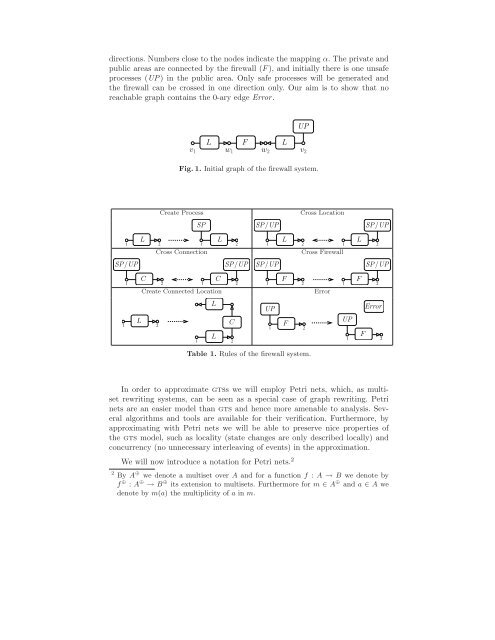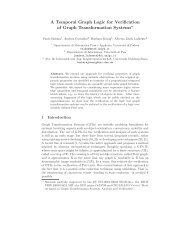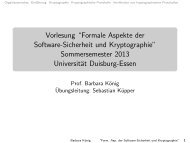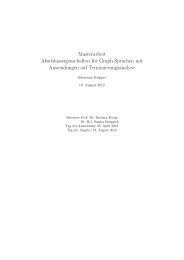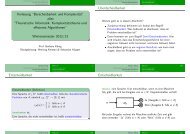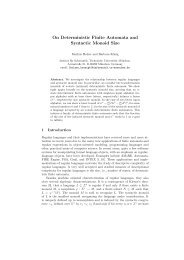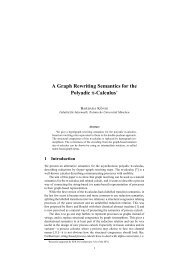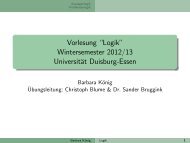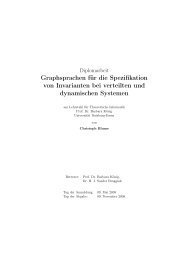directions. Numbers close to <strong>the</strong> nodes indicate <strong>the</strong> mapping α. The private andpublic areas are connected by <strong>the</strong> firewall (F), and initially <strong>the</strong>re is one unsafeprocesses (UP) in <strong>the</strong> public area. Only safe processes will be generated and<strong>the</strong> firewall can be crossed in one direction only. Our aim is to show that noreachable graph contains <strong>the</strong> 0-ary edge Error.UPv 1Lw 1Fw 2Lv 2Fig. 1. Initial graph <strong>of</strong> <strong>the</strong> firewall system.Create ProcessSPSP/UPCross LocationSP/UPL1 2 1 2Cross ConnectionSP/UPSP/UPC1 2 1 2LLCCreate Connected LocationL1 2LC1 2LL1 2 1 2Cross FirewallSP/UPF1 2 1 2UPF1 2ErrorUPFFSP/UPError1 2Table 1. Rules <strong>of</strong> <strong>the</strong> firewall system.In order to approximate gtss we will employ Petri nets, which, as multisetrewriting systems, can be seen as a special case <strong>of</strong> graph rewriting. Petrinets are an easier model than gts and hence more amenable to analysis. Severalalgorithms and tools are available <strong>for</strong> <strong>the</strong>ir verification. Fur<strong>the</strong>rmore, byapproximating with Petri nets we will be able to preserve nice properties <strong>of</strong><strong>the</strong> gts model, such as locality (state changes are only described locally) andconcurrency (no unnecessary interleaving <strong>of</strong> events) in <strong>the</strong> approximation.We will now introduce a notation <strong>for</strong> Petri nets. 22 By A ⊕ we denote a multiset over A and <strong>for</strong> a function f : A → B we denote byf ⊕ : A ⊕ → B ⊕ its extension to multisets. Fur<strong>the</strong>rmore <strong>for</strong> m ∈ A ⊕ and a ∈ A wedenote by m(a) <strong>the</strong> multiplicity <strong>of</strong> a in m.
Definition 4 (Petri net). Let ∆ be a finite set <strong>of</strong> labels. A ∆-labelled Petrinet is a tuple N = (S,T, • (),() • ,p), where S is <strong>the</strong> set <strong>of</strong> places, T is a set <strong>of</strong>transitions, • (),() • : T → S ⊕ assign to each transition its pre-set and post-setand p : T → ∆ assigns a label to each transition. A marked Petri net is a pair(N,m N ), where N is a Petri net and m N ∈ S ⊕ is <strong>the</strong> initial marking.3 Approximated UnfoldingIn this section we will give a short overview <strong>of</strong> a technique that approximatesa graph trans<strong>for</strong>mation system by a structure that is both a Petri net and ahypergraph [3–5].First we define <strong>the</strong> notion <strong>of</strong> Petri graph which will be used to represent anover-approximation <strong>for</strong> a given gts. Note that <strong>the</strong> edges <strong>of</strong> <strong>the</strong> graph are at <strong>the</strong>same time <strong>the</strong> places <strong>of</strong> <strong>the</strong> net and that <strong>the</strong> transitions are labelled with rules<strong>of</strong> <strong>the</strong> gts.Definition 5 (Petri graph). Let G = (R,G 0 ) be a gts. A Petri graph (overR) is a tuple P = (G,N,µ), where G is a hypergraph, N = (E G ,T N , • (),() • ,p N )is an R-labelled Petri net where <strong>the</strong> places are <strong>the</strong> edges <strong>of</strong> G and µ associatesto each transition t ∈ T N , with p N (t) = (L,R,id), a hypergraph morphismµ(t) : L ∪ R → G such that • t = µ(t) ⊕ (E L ) and t • = µ(t) ⊕ (E R ).A Petri graph <strong>for</strong> <strong>the</strong> gts G is a pair (P,ι), where P = (G,N,µ) is a Petrigraph over R and ι : G 0 → G is a graph morphism. A marking is reachable(coverable) in Petri graph if it is reachable (coverable) in <strong>the</strong> underlying Petrinet with <strong>the</strong> multiset ι ⊕ (E G0 ) as <strong>the</strong> initial marking.We view Petri graphs as symbolic representations <strong>of</strong> transition systems withgraphs as states. Specifically each marking m <strong>of</strong> a Petri graph (G,N,m 0 ) canbe seen as representation <strong>of</strong> a graph, denoted by graph(m), according to <strong>the</strong>following definition: We take <strong>the</strong> marked subgraph <strong>of</strong> G and duplicate each edgeas indicated by <strong>the</strong> marking.Alternatively one can define graph(m) as <strong>the</strong> unique graph H, up to isomorphism,such that H has no isolated nodes and <strong>the</strong>re exists a morphismψ : H → G, injective on nodes, with ψ ⊕ (E H ) = m. Fur<strong>the</strong>rmore, whenever<strong>the</strong>re exists a morphism ϕ : G ′ → G such that ϕ ⊕ (E G ′) ≤ m, <strong>the</strong>n <strong>the</strong>re existsan edge-injective morphism e m,ϕ :G ′ → graph(m) such that ψ ◦ e m,ϕ = ϕ.In order to obtain a Petri graph approximating a gts, we first need—asbuilding blocks—Petri graphs that describe <strong>the</strong> effect <strong>of</strong> a single rule.Definition 6 (Petri graph <strong>for</strong> a rewriting rule). Let r = (L,R,id) be arewriting rule. By P(t,r) = (G,N,µ) we denote a Petri graph with G = L∪R andN is a net with places S N = E L ∪ E R and one transition t such that p N (t) = r,• t = E L and t • = E R . Fur<strong>the</strong>rmore <strong>the</strong> morphism µ(t):L∪R → G is <strong>the</strong> identity.Given a gts G = (R,G 0 ) one can construct an over-approximating Petrigraph C G (also called <strong>the</strong> covering <strong>of</strong> G), using <strong>the</strong> following algorithm (see


